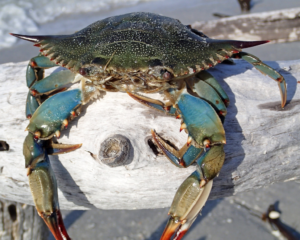Blue crab

Image of a female blue crab (Callinectes sapidus)
Image credit: James St. John for flickr 2013. https://www.flickr.com/photos/jsjgeology/24404627862
About
Blue crabs are found in the western part of the Atlantic Ocean including off the coast of Rhode Island. The largest population of blue crabs is found in the Chesapeake Bay (Save the Bay 1998). They are bottom dwellers and can be found in both salt and brackish water (fresh/salt water mix) between one and 36 meters deep. Their bodies are bright blue in the front and the rest is olive green to brown. Since they are a crustacean they grow by molting. Blue crab shells can grow to be 25 cm in length.
Males will mate multiple times while females will mate only once in their life. Two to eight months after mating, females will produce between two and eight million eggs via spawning. A female carrying eggs is known as a “berried” female”. Blue Crabs reach full size after molting between 18 and 20 times. They have a lifespan of one to two years, however they are often harvested by humans prior to that.
Callinectes sapidus are economically important to humans as a food source. They are often trapped and harvested commercially. Besides humans some of their predators include red drum, Atlantic croaker, herons, and sea turtles (Bodden 2011). Blue crabs typically predate on clams, oysters, and mussels, but will also consume other matter they find along the ocean floor.
Fun Facts
- Blue crabs can be cooked and eaten whole because of their soft shell (Save the Bay 1998).
- They are very aggressive when threatened (Bodden 2011).
- They hide by burrowing themselves into the sand (Bodden 2011). Ocean State Initiative for Marine Plasti…
- The name Callinectes sapidus means “beautiful savory swimmer” (Save the Bay 1998).
Citations
Bodden, s. 2011. “Callinectes sapidus” (On-line), Animal Diversity Web. Accessed April 20, 2020 at https://animaldiversity.org/accounts/Callinectes_sapidus/
Save The Bay, 1998. The Uncommon Guide to Common Life on Narragansett Bay. https://www.edc.uri.edu/restoration/html/gallery/invert/bluec.htm
